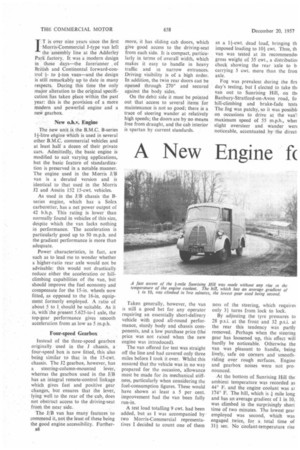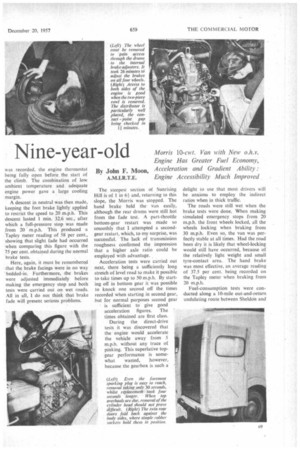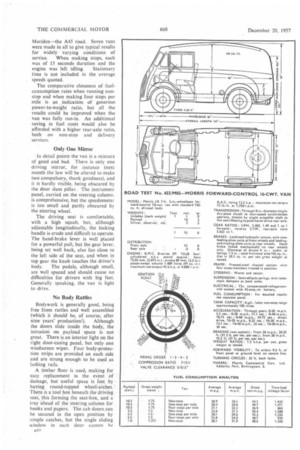A New Engine fc Nine-year-old
Page 42

Page 43

Page 44

Page 45

If you've noticed an error in this article please click here to report it so we can fix it.
Morris 10-cwt. Van with New o.h.v. Engine Has Greater Fuel Economy, (ion and Gradient Ability : Accessibility Much Improved
By John F. Moon, Accelera A.M.I.R.T.E. Engine IT is over nine years since the first Morris-Commercial J-type van left the assembly line at the Adderley Park factory. It was a modern design in those days—the forelunner of British and Continental forward-control -1to *-ton vans—and the design is still remarkably up to date in many respects. During this time the only major alteration to the original specification has taken place within the past year: this is the provision of a more modern and powerful engine and a new gearbox.
New o.b.v. Engine
The new unit is the B.M.C. B-series 1-1--litre engine which is used in several other B.M.C. commercial vehicles and at least half a dozen of their private cars. Admittedly, the basic engine is modified to suit varying applications, but the basic feature of standardization is preserved in a notable manner. The engine used in the Morris J/B van is a derated version and is identical to that used in the Morris J2 and Austin 152 15-cwt. vehicles.
As used in the JIB chassis the Bseries engine, which has a Solcx carburetter, has a net power output of 42 b.h.p. This rating is lower than normally found in vehicles of this size, despite which the van lacks nothing in performance. The acceleration is particularly good up to 50 m.p.h. and the gradient performance is more than adequate.
Power characteristics, in fact, are such as to lead me to wonder whether a higher-ratio rear axle would not be advisable: this would not drastically reduce either the acceleration or hillclimbing capabilities of the van, but should improve the fuel economy and compensate for the 15-in, wheels now fitted, as opposed to the 16-in, equipment formerly employed. A ratio of about 5 to 1. should be suitable. As it
• is, with the present 5.625-to-1 axle, the top-gear performance gives smooth acceleration from as low as 5 m.p.h.
Four-speed Gearbox •
Instead of the three-speed gearbox originally used in the J chassis, a four-speed box is now fitted, this also being similar to that in the 15-cwt. chassis. The J2 gearbox, however, has a steering-column-mounted lever, whereas the gearbox used in the JIB has an integral remote-control linkage which gives fast and positive gear changes, but ensures that the lever, lying well to the rear of the cab, does not obstruct access to the driving-seat from the near side.
The JIB van has many features to commend it, not the least of these being the good engine accessibility. Further e8
more, it has sliding cab doors, which give good access to the driving-seat from each side. It is compact, particularly in terms of overall width, which makes it easy to handle in heavy traffic and in narrow entrances. Driving visibility is of a high order. In addition, the twin rear doors can be opened through 270° and secured against the body sides.
On the debit side it must be pointed out that access to several items for maintenance is not so good: there is a trace of steering wander at relatively high speeds; the doors are by no means free from draught, and the cab interior is spartan by current standards.
Taken generally, however, the van is still a good bet for any operator requiring an essentially short-delivery vehicle with good all-round performance, sturdy body and chassis components, and a low purchase price (the price was not raised when the new engine was introduced).
The van offered for test was straight off the line and had covered only three miles before I took it over. Whilst this ensured that the vehicle was in no way prepared for the occasion, allowance must be made for its mechanical stiffness, particularly when considering the fuel-consumption figures. These would have shown at least a 5 per cent. improvement had the van been fully run-in.
A test load totalling 9 cwt. had been added, but as I was accompanied by two Morris-Commercial representatives I decided to count one of them as a 1-1-cwt. dead load, bringing th imposed loading to 10-1 cwt. Thus, th van was tested at its recommendel gross weight of 35 cwt., a distributioi check showing the rear axle to b carrying 5 cwt. more than the fron axle.
Fog was prevalent during the firs day's testing, but I elected to take till van out to Sunrising Hill, on till Banbury-Stratford-on-Avon road, fo hill-climbing and brake-fade tests The fog was patchy, so it was possiblt on occasions to drive at the van': maximum speed of 55 m.p.h., whet slight oversteer and wander wert noticeable, accentuated by the direct ness of the steering, which requires only 31 turns from lock to lock.
By adjusting the tyre pressures to 28 p.s.i. at the front and 32 p.s.i. at the rear this tendency was partly removed. Perhaps when the steering gear has loosened up, this effect will hardly be noticeable. Otherwise the van was pleasant to handle, being lively, safe on corners and smoothriding over rough surfaces. Engine and gearbox noises were not pronounced.
At the bottom of Sunrising Hill the ambient temperature was recorded as 44° F. and the engine coolant was at 174° F. The hill, which is mile long and has an average gradient of 1 in 10, was climbed in the surprisingly short time of two minutes. The lowest gear employed was second, which was engaged twice, for a total time of 31-1sec. No rcoolant-temperature rise
was recorded, the engine thermostat being fully open before the start of the climb. The combination of low. ambient temperature and adequate engine power gave a large cooling margin.
A descent in neutral was then made, keeping the foot brake lightly applied to restrict the speed to 20 m.p.h. This descent lasted 1 min. 32.6 sec., after which a full-pressure stop was made from 20 m.p.h. This produced a Tapley meter reading of 58 per cent., showing that slight fade had occurred when comparing this figure with the 75 per cent, obtained during the normal brake tests.
Here, again, it must be remembered that the brake facings were in no way bedded-in. Furthermore, the brakes were adjusted immediately before making the emergency stop and both tests were carried out on wet roads. All in all, 1 do not think that brake fade will present serious problems. The steepest section of Sunrising Hill is of 1 in 6-1 and, returning to this slope, the Morris was stopped. The hand brake held the van easily, although the rear drums were still hot from the fade test. A part-throttle bottom-gear restart was made so smoothly that I attempted a secondgear restart, which, to my surprise, was successful. The lack of transmission roughness confirmed the impression that a higher axle ratio could he employed with advantage.
Acceleration tests were carried out next, there being a sufficiently long stretch of level road to make it possible to take times up to 50 m.p.h. By starting off in bottom gear it was possible to knock one second off the times recorded when starting in second gear, but for normal purposes second gear • is sufficient to give good acceleration figures. The times obtained are first class.
During the direct-drive tests it was discovered that the engine would accelerate the vehicle away from 5 m.p.h. without any trace of pinking. This superlative topgear performance is somewhat wasted, however, because the gearbox is such a delight to use that most drivers will be anxious to employ the indirect ratios when in thick traffic.
The roads were still wet when the brake tests were done. When making simulated emergency stops from 20 m.p.h. the front wheels locked, all the wheels locking when braking from 30 m.p.h. Even so, the van was perfectly stable at all times. Had the road been dry it is likely that wheel-locking would still have occurred, because of the relatively light weight and small tyre-contact area. The hand brake was most effective, an average reading of 37.5 per cent. being recorded on the Tapley meter when braking from 20 m.p.h.
Fuel-consumption tests were conducted along a 10-mile out-and-return undulating route between Sheldon and
Meriden-the A45 road. Seven runs were made in all to give typical results for widely varying conditions of
service. When making stops, each was of 15 seconds duration and the engine was left idling. Stationary time is not included in the average speeds quoted.
The comparative closeness of fuelconsumption rates when running nonstop and when making four stops per mile is an indication of generous power-to-weight ratio, but all the results could be improved when the van was fully run-in. An additional saving in fuel costs would also be afforded with a higher rear-axle ratio, both on non-stop and delivery services.
Only One Mirror In detail points the van is a mixture of good and bad. There is only one driving mirror, for instance (next month the law will be altered to make two compulsory, thank goodness), and it is hardly visible, being obscured by the door slam pillar. The instrument panel, carried on the steering column, is comprehensive, but the speedometei is too small and partly obscured by the steering wheel.
The driving seat is comfortable, with a high squab, but, although adjustable longitudinally, the locking handle is crude and difficult to operate. The hand-brake lever is well placed for a powerful pull, but the gear lever, being set well back, also lies close to the left side of the seat, and when in top gear the knob touches the driver's
body. The pedals, although small, are well spaced and should cause no difficulties for drivers with big feet. Generally speaking. the van is light to drive.
No Body Rattles Bodywork is generally good, being free from rattles and well assembled (which it should be, of course, after nine years' production!). Although the doors slide inside the body, the intrusion on payload space is not great. There is an interior light on the right door-casing panel, but only one windscreen wiper. Four body-protection strips are provided on each side and are strong enough to be used as lashing rails.
A timber floor is used, making for easy replacement in the event of damage, but useful space is lost by having round-topped wheel-arches. There is a tool box beneath the driving seat, this forming the seat-box, and a tray ahead of the steering column for books and papers. The cab doors can be secured in the open position by simple catches, but the single sliding window in each door cannot he
If in locked except when shut. Similarly, the rear doors, when open, can be secured only when folded back against the body sides. There is no roof ventilator.
The highlight of the maintenance tests was the excellent engine accessibility, although the weird shape of the dipstick made the normally simple task of checking the oil level a 14minute job, including removal of the bonnet. The water level is easyto check, the filler neck being inside the cab, and this task was done in 7 seconds. Checking the level of the oil in the gearbox is simplified by the provision of a dipstick in the filler hole, which is shielded by a small plate in the floorboards.
Electrolyte Level Checked A trap in the main body floor gives access to the battery and is secured by a single budget lock. I checked the electrolyte levels in a minute without difficulty. The rear axle is reached through a trap in the rear of the floor, but I could not remove this without disturbing the test weights. The trap is secured by four setscrews.
Inspection of the brakeand clutchactuating fluid levels proved, to be an involved business. It was necessary to remove the floor mat and toe plate, after shifting both bonnet sections to gain access to one of the screws holding the toe board in place. Although this is made to sound easy in the driver's manual, it takes 10 minutes to check these two levels—sufficient to discourage regular attention.
It requires 1.4min. to remove both bonnet sections, the top panel alone taking only 15 sec. With the panels off I removed No. 1 sparking plug in 30 sec. and replaced it in 34 sec., no diffi-. culty being experienced. Checking the contact-breaker-points gap took only I+ min. A works fitter had to turn the starting handle while I watched the points, as it was impossible to see the distributor from the front.
Tappet Adjustment Simple Tappet clearances were checked in 61 mm. The simplicity of the task contrasted strongly with the difficulty occasioned by the side-valve engine formerly fitted. I did not attempt to remove the oil-filter clement because I was short of time, but there is an external oil pipe to remove before the filter bowl can be withdrawn and the operation is not likely to be quick.
Replacement of the bonnet panels occupied 55 sec., but it should be pointed out that I did not disconnect the carburetter cold-starting control from the lower bonnet section. Had I done so bonnet removal and replace
ment would have taken much longer.
I found it difficult to change a fuse because the fuse box is hidden in front of the steering column, close to the tray fo-r papers, and the fuses themselves arc concealed behind a maze of untidy wiring. Here, again, the drawing in the driver's manual (which shows no wires) makes the job look easy.
Brake adjustment, as on several other small B.M.C. vans, involves removal of the wheels to gain access to the holes in the brake drums through which the brake adjusters are reached. This seems even more ridiculous in the case of the .11B chassis, because the Wheels have holes —but these do not coincide with those in the drums!
However, by jacking up both wheels of each axle simultaneously I managed to adjust the front brakes in 14 min. and those at the rear in 12 min. The combined times are longer than is required to adjust the brakes of an average eight-wheeler! The spare wheel is stowed under the rear of the body, where it can be removed without disturbing the payload, and the wheel was taken out in 1:min. and replaced in 2 min., the wheelbrace fitting the single securing bolt. Because rubber-bonded bushes, are used throughout the suspension system, except at the front-spring fronthanger brackets, grease-gun lubrication is cut to a minimum. There are only 14 points requiring attention, eight being on the steering linkages. There are only two propeller-shaft nipples; the sliding spline is contained inside the gearbox-extension housing.
Easy to Top-up
The steering box is easy to top-up, a nipple for an oil gun being provided in the driver's toe plate. The standard tool kit is particularly comprehensive, and the tools are of a good quality.
The Morris 1713 van, complete with the standard 150-cu.-ft. body, sells for a basic price of £458, plus £74 12s. 9d. purchase tax in Great Britain. The chassis alone has a basic price of £319 10s. (the purchase tax is the same as for the complete van). A chassisand-front-end version is also available at a basic price of £348. Although offered for export, a left-hand-drive model is not available.
The Austin Motor Co., Ltd., also market this vehicle under their own name. It differs only in having a different grille panel.




























































































